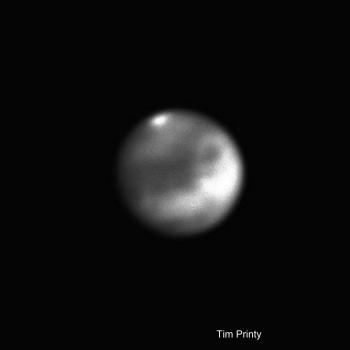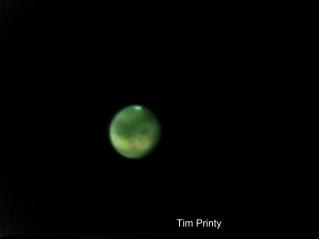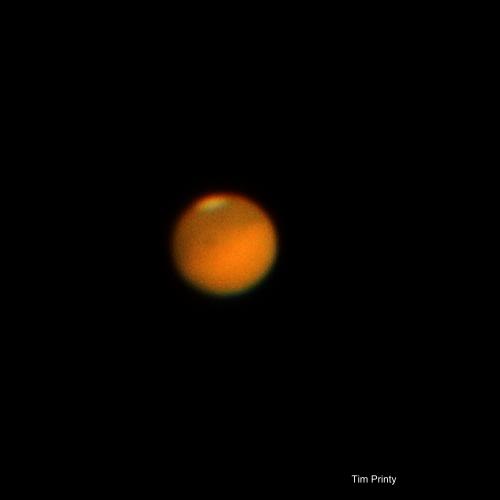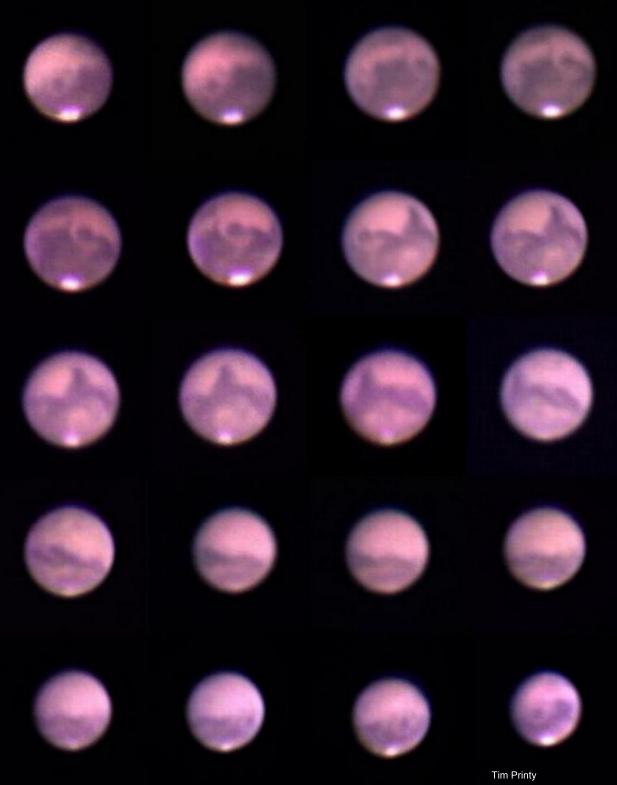
The Great Mars opposition of 2003
Tim Printy
In 1988, I had the good fortune of observing and photographing Mars from Orlando, Florida. Over several months, I was fascinated and intrigued by the details and became familiar with all the features that one could see. However, my photographs seemed to pale into comparison with what was observed. Even when using fine grained Technical Pan 2415 film, I was still left wanting for more detailed images. Below is probably the best photograph of that time period.

Digital photography was in its infancy at the time and, in cooperation with fellow amateur astronomer Dale Hatch, I attempted some video images of the red planet. This was an improvement but the resolution still seemed to be below what I desired. After capturing some of the video digitally, I decided to experiment with "stacking" of the images. Using the freeware program Registax (http://aberrator.astronomy.net/registax/), I successfully stacked some of the frames together and was quite impressed with the results. Compare this with the above photograph.

What is obvious in the video image is that I could obtain resolution far greater than that with conventional films without the hassle of taking pictures using an extension tube and long exposures. Still photography with exposure times of 1-4 seconds introduced far too many variables into the images such as:
1) Polar alignment had to be accurate so the image would not drift during the exposure
2) Variables in the scopes motor drive could introduce periodic errors that caused images to blur.
3) Atmospheric variables could blur the image during the exposure.
4) Vibrations from the camera shutter could cause the image to shift.
What was needed was a sure way to capture the image digitally (without great expense in purchasing an expensive digital camera) so I could stack them with the registax program and give me fairly good quality images of the planet.
Initially, I attempted to capture Mars with my digital camera I bought for family and daylight pictures by shooting afocally through the telescope.

This had too many variables and was difficult. Additionally, the 2.0 Megapixel resolution was really inadequate for the task. While some may find it to be an acceptable image, I felt it was no better than some of my color shots on Ektachrome 200 taken back in 1988. I could purchase an expensive camera with higher resolution but I felt that still would not be enough. There had to be a bettter method without shelling out a lot of cash.
I began to read about using a webcam as a camera for planetary images. With Mars rapidly approaching opposition, I decided to purchase a Logitech webcam Pro (it was on sale for $89 after rebate) and attempt to attach it to my Meade 10" Schmidt-Cassegrain telescope (SCT). After a bit of fudging and finding the right screw, I was able to remove the webcams lens and create a crude 1-1/4" adapter to attach the camera ball to my telescope. After a few trial and error shots that night, I was set. Over the next month and a half, I managed to document one full rotation of the planet. Unfortunately, my latitude in New Hampshire is much higher than it was in 1988, when I was located in Orlando, Florida. Mars was also lower in the sky. As a result, I had to deal with many nights which involved poor atmospherics. This resulted in reduced resolution. Still the results were pretty good considering.

All images were taken with a Logitech Webcam pro using a 10" Meade SCT and a 2X barlow (making the setup F20). The videos were originally 15-30 seconds in length and at a resolution of 640X480 pixels and a shutter speed of 1/300 second. Using the program Registax, I then stacked the images to produce a raw image. The resultant image was then processed using Adobe Photoshop 5.0 and Photo Impact 3.0. Images were cropped and put in the following mosaic. The first image was taken the night of August 22 and the last taken on September 30.
One can only hope that I will be as successful with the 2005 opposition when Mars will be much higher in the sky. I also am looking forward to doing some work on Saturn and Jupiter this winter and fall. Stay tuned for more web pics.